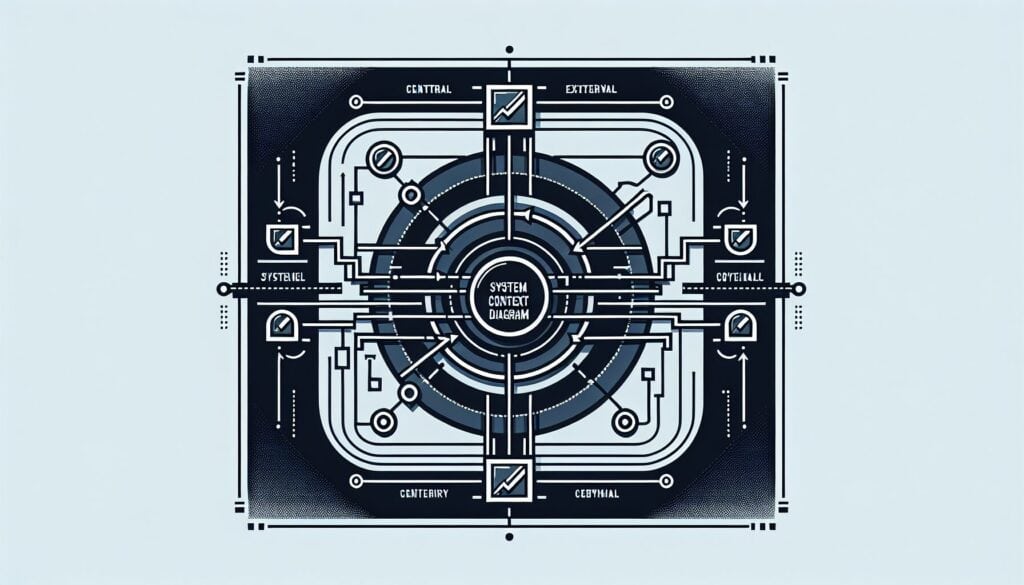To define the boundary between a system and its environment, showing the entities that interact with it.
- Methodologies: Customers & Marketing, Ideation, Product Design
System Context Diagram

System Context Diagram
- Agile Methodology, Process Mapping, Project Management, Quality Management, System Design, User experience (UX), User Interface (UI), User-Centered Design
Objective:
How it’s used:
- A high-level diagram that shows the system as a single process along with its inputs and outputs from/to external entities (e.g., users, other systems). It sets the scope of what is to be included in the system.
Pros
- Simple and easy to understand, even for non-technical stakeholders; Clearly defines system scope and boundaries; Helps in identifying all external interfaces and stakeholders.
Cons
- Provides a very high-level view and lacks detail about internal system workings; Can be too simplistic for complex systems; May not capture all nuances of system interactions.
Categories:
- Customers & Marketing, Engineering, Product Design, Project Management
Best for:
- Establishing the scope of a system and identifying its external interactions and interfaces early in a project.
System Context Diagrams are widely utilized in various sectors including software development, engineering, and product management as a means to clarify the interactions between a system and its environment. They prove particularly advantageous during the early phases of a project when requirements are being gathered, allowing teams comprising project managers, system architects, and stakeholders to visually encapsulate the system’s exterior elements, including end-users, other systems, and data sources. Industries such as telecommunications, manufacturing, and healthcare frequently adopt this methodology to ensure that all stakeholders comprehend the designed system’s boundaries and responsibilities. For instance, in healthcare IT projects, a System Context Diagram can depict how a patient management system interacts with external databases and medical devices, thus facilitating a shared understanding among clinical staff and IT professionals. Participants in the process typically include interdisciplinary team members—such as business analysts who articulate business needs, engineers who provide technical feasibility assessments, and compliance officers who must ensure regulatory guidelines are met. This diagrammatic approach not only simplifies communication with non-technical stakeholders but also lays a solid foundation for further methodologies like Functional Decomposition and Use Case Analysis, ensuring that the project’s direction remains aligned with stakeholder expectations and requirements as it evolves through subsequent phases.
Key steps of this methodology
- Identify the system to be modeled.
- Define external entities that interact with the system.
- Determine the inputs and outputs for the system.
- Draw the system as a single process in the diagram.
- Connect external entities to their corresponding inputs and outputs.
- Review the diagram for clarity and completeness.
Pro Tips
- Involve stakeholders early to validate identified inputs and outputs, ensuring all relevant perspectives are captured.
- Utilize iterative reviews of the diagram as the project evolves to adapt to changing requirements and maintain clarity.
- Document assumptions made during diagram creation to provide context for future project phases and decision-making processes.
To read and compare several methodologies, we recommend the
> Extensive Methodologies Repository <
together with the 400+ other methodologies.
Your comments on this methodology or additional info are welcome on the comment section below ↓ , so as any engineering-related ideas or links.
Historical Context
1980
1980
1986
1987
1990
1990
1990
1980
1980
1986
1986
1987-03
1990
1990
1992
(if date is unknown or not relevant, e.g. "fluid mechanics", a rounded estimation of its notable emergence is provided)















Related Posts
Musculoskeletal Discomfort Questionnaires
Multivariate Testing (MVT)
Multiple Regression Analysis
Motion Capture Systems
MoSCoW Method
Mood’s Median Test